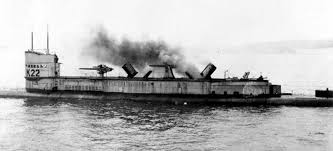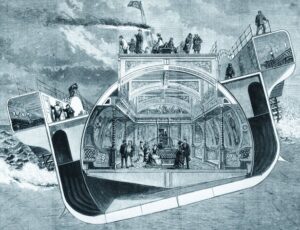The Royal Navy took rather a dim view of submarines in their early days. This manifested itself in several ways, though perhaps the most obvious is that they were allocated numbers instead of names. Only proper ships have names. Even the insistence on calling them boats – despite their latest descendants displacing nearly 16,000 tons and carrying enough explosive firepower to make Jutland look like a fart in the bath – hints at a residual snobbery. And it’s hard not to assume that this attitude is detectable in the designs of their subs.
Exhibit A in this particular argument is always the K-Class. They’re essentially one of those ideas that provides its own punchline – the oil-fired, steam-powered submarine – and yet somehow the execution was even worse.

Amongst their other foibles, the K-class were capable of diving uncommanded (in a boat full of holes!), when they dived deliberately the bow could be at crush depth whilst the screws beat the air uselessly, and it’s claimed they took half an hour to prepare to dive safely. Although “safely” was, as we’ve established, a strictly relative term and the actual record for diving – presumably unsafely – was 3 minutes 24 seconds*. Oh, and the swivelling torpedo tubes were fairly useless, although not quite as useless as the torpedoes they contained. The only time a K-Class fired on an enemy vessel it was rewarded with a series of dull thuds as the torps bounced harmlessly off.
Indeed the Ks barely saw combat. Entering service too late in the war to have much to shoot at, they remedied the lack of action with 1918’s Battle of May Island, in which a brief moment of jammed steering gear led to the loss of two submarines and damage to four others. The incident was considered so embarrassing that much of it – including details of the resulting courts martial – was hushed up until 1994. We’d invented Britpop by then! And wished we hadn’t.
But here’s the rub: the K-Class did exactly what it was designed to do. Well, apart from all the defects and the whole Battle of May Island debacle. That definitely wasn’t in the brief.
The K-Class were, however, trying to square a very awkward circle. The Royal Navy wanted a submarine that could plausibly keep up with the fleet and then either ambush a retreating enemy or create havoc on the flanks. That the Ks were happily capable of causing havoc in the absence of the enemy was merely an unfortunate sidenote to this ambition.

To keep up with the fleet meant the K-Class had to be fast. The intention was that they could operate at 21 knots, but the final design blew that out of the water – the only thing a K ever would. Capable of 24 knots on the surface, a speed not matched until the 1960s, the Ks were seriously rapid. But that came at a cost…
To obtain that speed they simply had to be powered by steam turbines. Diesels had been tried with mixed success in the preceding J-Class but struggled to push the vessel above 19 knots. The fact that the boilers could only be fired on the surface wasn’t a showstopper as submarines of the time were expected to be quicker on the surface than submerged anyway. Amps for the electric motors were smaller then or something.
The Ks also had to be big – size and speed are generally linked in maritime affairs – and if anything that was a bigger issue than all those holes in the roof. They were the length of a small cathedral but had roughly the same manoeuvrability – and probably a similar amount of praying on the inside when they were asked to turn sharply. It didn’t help with controlling the boat’s attitude whilst diving either – the controls of the time simply weren’t quick or accurate enough to easily retain control.

Whether they needed that pace is a slightly more dubious point. It’s been suggested that the Royal Navy were bounced into the idea of the fleet submarine by reports that the Germans were trying it – and it’s worth noting that the Germans didn’t manage to make it work either. Nobody really did. The idea of submarines acting with the fleet directly, rather than sneaking around to the expected ambush point, disappeared with experience. Having the Ks prove that the experience was horrible certainly can’t have done much to promote it.
But that, really, is where the defence rests: if there was a problem with the Kalamity Class, it was the concept itself. To meet it the K-Class was asked to do just one thing at all costs – be fast – and at 24 knots they certainly met the brief.
Now if only somebody had thought to request they avoid the rest of their nonsense…
* There’s some contradictory information on the diving times. It’s claimed K8 achieved a dive in 3 minutes 24 seconds, and the design specification was certainly to be able to dive in fewer than five minutes. On the other hand the 30 minute figure crops up a lot and the incredibly specific 24 minutes and 15 seconds has also been attested. What I think is going on here is different criteria, with a crash dive under wartime conditions relying on a lot fewer safety measures than a more controlled dive with the boilers entirely damped etc. The latter would allow the boiler room to be left open to the rest of the submarine, with a consequent ability for the crew to check those holes for leaks. That would leave us with figures of 24ish minutes on average and perhaps 4 or 5 minutes in a rush – something that sounds more plausible as a war machine.
11 thoughts on “In defence of the K-Class…”
Comments are closed.



Its rare that one of your write ups feels more upbeat than the corresponding Wikipedia article, you must have a soft spot for the K Class! 🙂
True. I don’t think the Wikipedia article gets across how audacious the concept itself was given the technology of the day, and that’s what really did for the Ks – every decision necessary to deliver the speed made it harder to build a sensible submarine.
They make marginally more sense if you consider them as a surface ship that can hide underwater.
Although taking half an hour to “hide” might be deemed to take some of the gloss off that party trick – especially since once under water presumably the only weapons it could deploy were its not terribly effective torpedoes?
And while popping up mid battle and saying “surprise, here’s another surface ship that’s been hiding!” could be useful if it had a full complement of surface ship armament I’m assuming that was sacrificed in the search for speed/submersibility so they’d need to pop up really, really close to the enemy in order to actually do any useful damage (if at all)?
The concept was that they could sail with the fleet, and would then detach to lurk somewhere the enemy were expected to cover later, particularly a line of retreat. It’s interesting though that the Royal Navy were already anticipating both Jutland and Dogger Bank in that regard, with the High Seas Fleet needing to preserve its ships when faced with a substantial portion of the British fleet. They might also have been used as a picket – they were later fitted with pretty powerful radios, possibly to facilitate a scouting role.
My point about thinking of them as surface ships that can submerge is more about their range and ability to move with the fleet, and that the underwater performance was no more than adequate at best.
I’m probably going to amend the dive time in the article, as it’s almost certainly an exaggeration possibly based on the time for boilers to cool off enough that the boiler room could be left open? In a crash dive – and the Ks could obviously crash more than most – they could be sealed off. That meant the biggest space in the ship – and the one with all the holes in it – couldn’t be seen though…
The lurking & scouting with a powerful radio certainly does make sense – especially in a pre-sonar & pre-radar age. There probably weren’t any other efficient ways to get that capability at the time, and since the original plan probably included an assumption of effective torpedoes the idea would have been a fine one.
This would work well as the second half (a new twist!) of a longer (not necessarily “long”) article on the K.
One thing about the Ks that strikes me is that the prolonged dive times seem to negate much of the point of a high “sprint speed.”
True, although the major point of having that speed was so that they could steam with the rest of the fleet when they were required.
In the great visual dictionary of metaphors, the K-Class boldly illustrates the phrase “disaster waiting to happen”..
Excellent article, my only disappointment is that you couldn’t squeeze in my favourite description of them (“the speed of a destroyer and the bridge facilities of a picket boat” – hence, partly, the May Island events). The cathedral simile makes up for it.
‘The most fatal error imaginable would be to put steam engines in submarines.’
John, (Jacky), Arbuthnot Fisher – 1913.